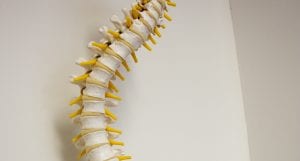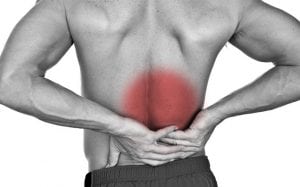If you’re suffering from low back pain you’ll certainly already know that the condition can be painful and hugely disruptive to your everyday life – but what causes back pain, what’s the source of the problem, and how do we classify back pain? Over the next few weeks, we’ll be taking an in depth look at the condition which brings more people to the Chiropractor than any other!
How common is low back pain?
If you’re struggling with low back pain, you can at least take some comfort from the fact that you are in good company. There’s no question that low back pain (LBP) is an extremely common health problem.
In fact, Low back pain is the leading cause of activity limitation and days off work throughout much of the world and it causes an enormous economic burden on individuals, families, communities, industry and governments.
Official figures do vary, but research suggests that up to 85 percent of adults endure low-back pain (LBP) sometime during their lives. What’s worse, many of the medications used to relieve LBP carry hazardous side effects – In many cases, drugs aren’t fully effective in reducing the pain either.
About your back
Your back has many connected parts, including bones, joints, muscles, ligaments, nerves and tendons. Your spine is the core of your back and supports your entire body. The spine is made up of 24 separate bones called vertebrae stacked on top of one another.
Below these are the bones in your sacrum and coccyx, which are at the bottom of your spine. Between the vertebrae are discs that act as shock absorbers and allow your spine to bend. Your spinal cord threads through the vertebrae. It carries nerve signals between your brain and the rest of your body.
The spinal cord ends in your lower back and continues as a bunch of nerves. This is called the cauda equina, Latin for ‘horse’s tail’, which it’s thought to resemble.
For your spine to function optimally, and without any pain, the vertebrae must all be correctly aligned, the supporting muscles must be moving freely and without construction, the nerves must not be pinched or obstructed and the connective tissue holding the whole structure together must be in good order.
Back pain is usually the result of an issue with one or more of these areas.
Most low back pain results from an issue in the lower, or Lumbar, spine – however, you might experience referred pain in other regions of the spine.
Symptoms of lower back pain
The symptoms of low back pain include the obvious pain in the lower back – but depending on the case of the pain there are many other symptoms which can be associated.
For long-term sufferers, it is common for some of the associated symptoms of back pain to be viewed as new and concerning symptoms causing additional distress- when in fact, they may be just another manifestation of the low back pain.
The pain in your lower back may come on suddenly, perhaps after you’ve lifted something heavy, or have been injured during a sporting activity – it may come on gradually over time. In terms of intensity, back pain can range from a constant low-intensity ache to severe and debilitating pain.
In addition to the pain in your lower back, it is common to experience pain down one leg, or into the buttock or groin. This is sometimes called sciatica. Referred pain (where the pain from your lower back manifests elsewhere) is also seen regularly, with consequences ranging from a feeling of tightness in the chest to stomach pains.
You’ll probably find that the pain is worse when you move, and better when you lie down (although this won’t always be the case) This may make it hard for you to carry out your usual day-to-day activities, and you may find it difficult to sleep well. In some cases, back pain may come and go, and you may find that you have good days and some less good days – in other instances the pain is near constant.
You should seek medical attention right away if you:
- have numbness or tingling around your bottom or genitals
- have sudden difficulty passing urine
- lose control of your bowels
- are unsteady when you walk, your legs feel weak or your foot is dropping or dragging
Types of lower back pain
There are two main types of lower back pain (and back pain in general) – these are the specific, and non-specific types.
Non-specific back pain
When symptoms of back pain don’t have a specific cause such as an underlying medical condition or injury, they are known as ‘non-specific back pain’.
This is by far the most common type of back pain. If you visit your GP, they are unlikely to be able to tell you exactly what’s causing the pain – It’s often caused by a simple strain of the muscles, tendons or ligaments around your back, or by issues related to an old injury, poor posture or, commonly, vertebral subluxation. Without taking an X-ray and performing a wide variety of diagnostic tests (which GP’s just don’t have time to do) the truth is they have only a very small chance of correctly identifying the root issue.
There may be a specific event or movement that started your back pain. Perhaps you were straining, twisting or lifting something heavy – which is very common with low back pain episodes.
Alternatively, the back pain may have come on gradually. In some people, it’s linked to repetitive tasks at work or sitting in one position for a long time in a poor posture. Back pain may also occur as a result of the normal ‘wear and tear’ on the bones of your spine as you get older.
Because of its complexity and diverse nature, Non-specific back pain is best investigated by a spinal specialist such as a Chiropractor. Most Chiropractors work with non-specific back pain more than any other condition, and (unlike most medical doctors) have the time and experience in dealing with Non-specific pain to really get to the root of the issue.
Specific back pain
Sometimes, damage to parts of your spine can be the cause of back pain. Examples of this are:
- A slipped (herniated) disc – when a disc bulges and puts pressure on your spinal nerves
- A fracture – a crack or break in one of the bones in your back, perhaps due to osteoporosis
- Inflammatory low back pain – caused by a condition such as ankylosing spondylitis. In this condition, your immune system causes inflammation in the spinal joints and ligaments
- A tear or strain to a muscle implicated in spinal movement or support
Remember, if you are unsure of the cause of your back pain, or if you are in severe pain, it is always advisable to seek medical attention, starting with your GP – however, cases of non-specific pain are better attended to by spinal specialists. If you have private healthcare, ask your doctor for a referral to a Chiropractor, Sports therapist or Physiotherapist – such referrals are usually included in your cover and will often be suggested by your Private doctor when Non-specific back pain is suspected.
Check back next week for the low down on treating back pain!

